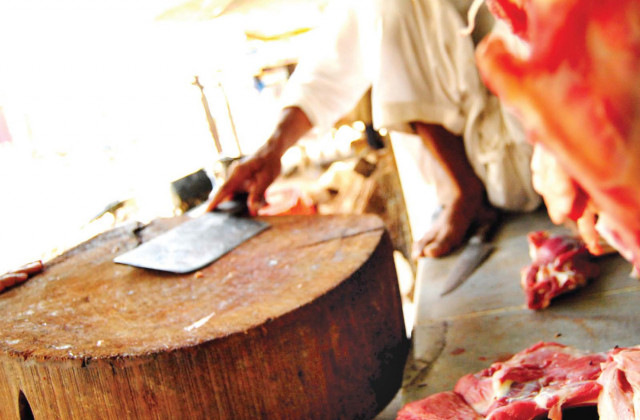The sins of the flesh

A study, “Microbial Contamination of Raw Meat and its Environment in Retail Shops in Karachi”, conducted by five researchers in 2009 was published earlier this year in the Journal of Infection in Developing Countries.
The research confirmed the presence of at least 550 potential pathogenic isolates in samples of meat, as well as equipment used to cut and display meat at shops. Thirty retail outlets located in main Saddar Market were randomly selected for the study. A total of 340 meat and surface samples were also collected.
The study showed the process by which pathogenic bacteria, or disease-causing bacteria, is transferred from the environment to the meat and to the cutting apparatuses, given the hygiene conditions in most retails shops of the city. The researchers also found that these strains of bacteria were resistant to antibiotics, probably because the animals are fed them at some point along the livestock farming line.
The authors included Nafisa Hassan Ali, Amber Farooqui, Adnan Khan, Ameera Yahya Khan and Shahana Urooj Kazmi, who is also a professor at the Department of Microbiology and the pro vice-chancellor of the University of Karachi.
The grilled food sold on roadside stalls may appear delicious but it is not hygienic, said Dr Kazmi, adding that most of the times the meat is half-cooked, meaning that bacteria is still present. “Minced meat, which has the greatest amount of such bacteria, is often used at restaurants to make kababs and burger patties that are cooked for a very short time and hence are very dangerous to consume,” she told The Express Tribune.
While some people have started opting for packed meat sold at supermarkets, 23 per cent of the households still buy raw meat from open-air retail shops that do not have appropriate temperature controls.
“If we do not store the meat at low temperatures then a lot of micro organisms will definitely grow on it because it is a rich source of proteins,” explained another researcher.
Dr Kazmi pointed out that although this bacteria can cause various complicated infections, such as typhoid and diarrhea, they are not usually transferred to our cooked food. This is because of the vigorous cooking styles followed in the sub-continent, she added. “Fortunately most of these bacteria die at high temperatures and hence do not harm us,” she explained.
According to Dr Kazmi, the overall storage and quality control methods of slaughter animals are not satisfactory. According to the West Pakistan Slaughter Control Act 1963, slaughtering should be strictly undertaken in recognised places with ante- and post-mortem veterinary inspection, she said, adding that we do not have any scientific diagnostic laboratories at our slaughterhouses.
“What our veterinary officer does is just brush his hand over the body of the animal and if the fur sticks to his hand, the animal is declared fit,” she said.
With insufficient facilities, the number of animals slaughtered outside the two government-controlled slaughterhouses is much higher than those within them, Dr Kazmi said dejectedly. The slaughterhouses have poor hygienic conditions with unclean equipment and to top it all, meat is transported to the retailers in open trucks that add to the contamination, she added.
Butchers at the Burnes Road market, for example, have been known for the quality of their meat. Amjad, a butcher who sells beef, says customers trust him more because he slaughters his animals close to the shop, thereby doing away with the hazards of transporting it. “Our meat is sold within hours after being put on display,” he claimed. “We have old customers who know the quality of our meat.”
Much like Amjad, most of the butchers in the city manage the business with very little interference of the authorities. There are some who sell old meat at their shops for relatively lower prices to lure poor customers.
While the City District Government Karachi’s health department has improved the conditions for slaughtering and transporting meat, there still remains a lot to be done, Dr Kazmi believed.
With recent reports of Congo virus patients this month, there is an urgent need for enforcing strict sanitary methods, she stressed. The Congo Crimean Hemorrhagic Fever Virus, a level 4 pathogenic disease, is actually carried by ticks in the fur of cattle and ruminants that gets transferred to the animal. When such an animal is slaughtered, the virus can easily get transferred to humans either through blood or tissue contact or through meat consumption.
In order to adopt a healthier lifestyle, Dr Kazmi suggested that there are proper sanitation procedures at slaughter houses and butcher shops. The hygiene of the butcher and the health of the animal should also be taken care of. Lastly, the meat should be cooked well before eating.
Another factor found in this study was that consumer platforms and counters of the shops were cleaner than the floors as they were probably mopped several times during the day.
Published in The Express Tribune, August 2nd, 2010.



















COMMENTS
Comments are moderated and generally will be posted if they are on-topic and not abusive.
For more information, please see our Comments FAQ